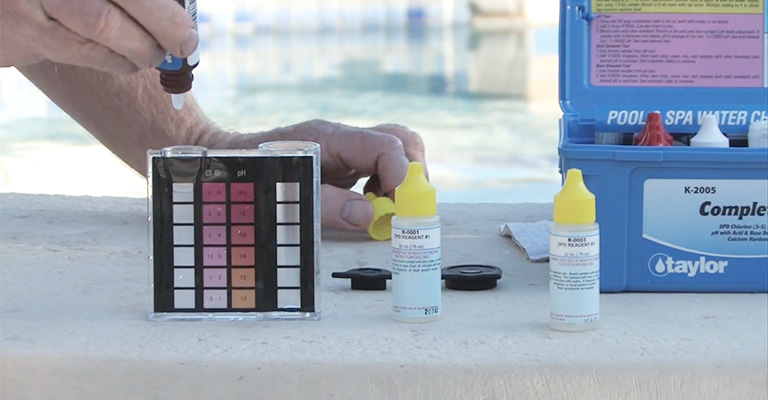When it comes to pool maintenance, maintaining optimal chlorine levels is vital to a clean and safe swimming environment.
As a pool owner, you understand the importance of chlorine in sanitizing the water and keeping it free from harmful bacteria and contaminants.
Pool water can be treated with chlorine to increase the level of free chlorine. Whether it is chlorine tablets, granular chlorine, or chlorinated shock, chlorination can solve the problem.
A basic building block of matter, chlorine occurs naturally in the environment. It possesses powerful disinfecting and bleaching abilities to maintain the cleanliness of our swimming pools and other industrial applications.
Whenever you choose a pool installation company, they should be able to walk you through the different materials you will need for your new or renovated pool.
What Is Free Chlorine?
Measurement of chlorine-free is measured in parts per million (ppm), which can be used to eliminate harmful microbes and neutralize contaminants.
There are no microbes or chemicals in the water to bind to yet. Monitoring free chlorine is a crucial part of pool maintenance because it helps avoid harmful contaminants in the pool.
Safe Chlorine Levels for Pool Water
Water safety can be ensured, and chloramine buildup minimized by keeping chlorine levels within the recommended range.
A swimming pool water test kit can help determine if chlorine levels are outside the optimal range. However, swimmers might notice a chlorine smell or feel mildly irritated.
Do not let swimmers into the pool until proper treatment has been performed and the levels have been tested within range.
Total chlorine: Generally speaking, it should be equal to free chlorine
Combined chlorine: Ideally, less than 0.2 parts per million, below 0.5 parts per million.
Free chlorine: in the ideal range, 1.0 to 6.0 ppm, and within the safe range, 2.0 to 4.0 ppm
How To Raise Free Chlorine Levels In A Pool?
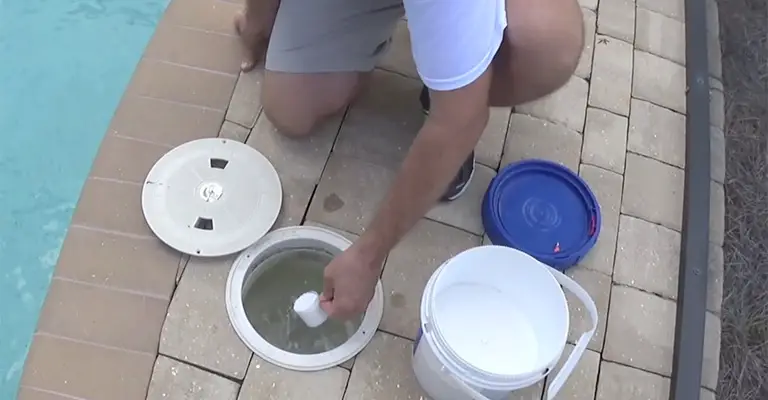
To increase your chlorine level, ensure your free chlorine level is greater than 1 part per million (ppm).
Pool water that has a chlorine level below or equal to 1 ppm hasn’t been sanitized, which can lead to algae growth and bacterial growth.
Suppose you have added chlorine tablets or granules, but the levels remain unchanged. How do you raise free chlorine once you have added chlorine to a pool?
If your chlorine levels are too low (1 ppm) or your pool water isn’t reading chlorine at all (0 ppm), shock your pool with chlorine-based shocks.
You may suffer from a high chlorine demand problem if your chlorine levels remain low, even after shock.
You will likely have low free chlorine levels if you haven’t cleaned your pool yet, and there’s a lot of debris because the free chlorine is busy cleaning all the contaminants.
You should clean and remove debris from your swimming pool before testing its chlorine level.
Test your water next. The pH, alkalinity, and cyanuric acid levels should be in the proper range. Learn about pH and cyanuric acid if you need assistance balancing your water chemistry.
You should shock the water in your pool after cleaning and balancing the other levels. You shock your pool when the chlorine levels get to a point where they reach a chlorine breakpoint.
This increases the chlorine levels 10 times over what is generally found in the pool. The pH level of your pool can be affected by the chlorine pool shock you use, and the type of chlorine pool shock you use can have many different effects on your water.
A shock that does not contain chlorine will decrease your combined chlorine level but not raise your free chlorine level. During a non-chlorine shock, oxidation breaks up contaminants without adding chlorine.
For Salt Water Pool Owners
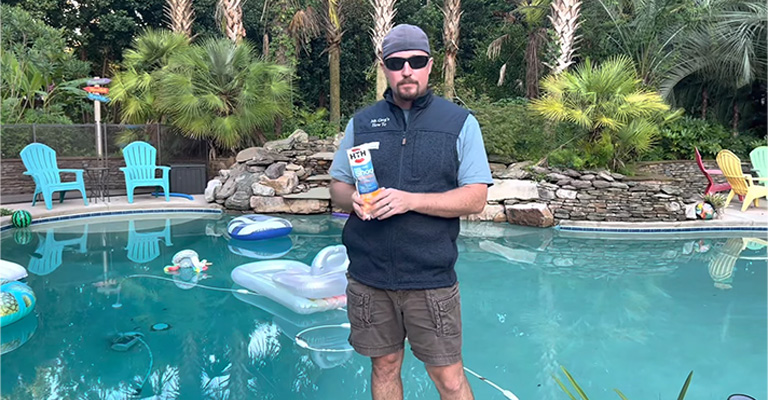
Apply Sodium Dichlor Shock. You can raise your chlorine level without building upscale on your saltwater generator with shock.
In addition, it will increase your levels of cyanuric acid (CYA). Therefore, liquid chlorine is ideal if you already have high CYA levels.
For Traditional Chlorine Pool Owners
Using Cal-Hypo Shock will help. You can instantly raise your free chlorine levels with Cal-hypo, as it is the most potent chlorination shock available.
Due to cal-hypo shock’s unstabilized chlorine content, you will do your pool’s shock at night to prevent rays from destroying it.
Once you have swum, don’t do it for at least 8 hours. Nevertheless, if you suspect your pool has high chlorine demand (lots of contaminants and a reading of 0 ppm), you have to triple-shock it.
How to Test Pool Water for Free, Combined and Total Chlorine?
To monitor free, combined, and total chlorine, select one of the following methods:
- Test strips,
- A chlorine test kit or
- A digital chlorine sensor.
The color of the litmus test strip changes when it contacts water. It indicates the approximate total chlorine level, free chlorine, and combined chlorine.
With a chlorine test kit, you add a chemical reagent to a pool water sample, which changes color depending on the amount of chlorine in the sample.
It is most accurate to monitor chlorine levels with an electronic chlorine tester. With these devices, you can get precise measurements, rather than an approximate range, without comparing colors.
What Causes Low Free Chlorine Levels?
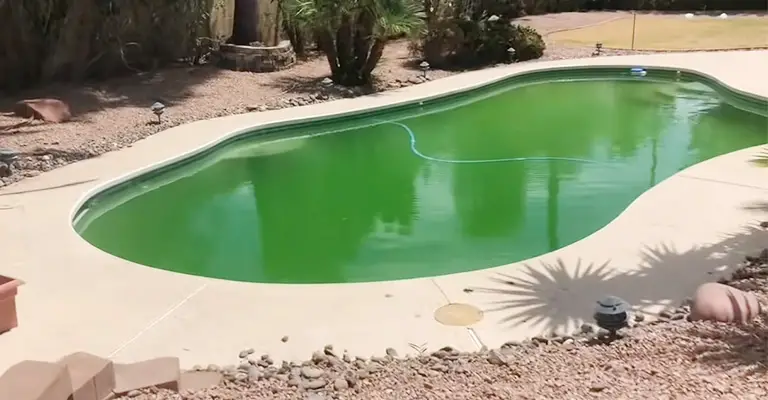
The first step towards raising your pool’s free chlorine is to understand what caused it. A sudden or chronic decrease in free chlorine levels can be caused by several factors.
High Chlorine Demand
The effect of chlorine on sanitizing is limited. It will require more chlorine to sanitize water effectively if you have a high bather load or a lot of debris in the water.
You will need more chlorine to treat your swimming pool water when there are more contaminants in it. Stagnant pool water with untreated chlorine will most likely require chlorination during the winter.
You may also experience chloramine demand if your yard floods with rain, especially if you experience heavy rainfall. If you recently added chlorine or a chlorine-based shock, your pool may have a chlorine demand issue.
Not Enough Salt in Your Salt Water Pool
When your saltwater generator produces low chlorine levels, your pool will not have enough salt. The salt cell functions correctly only when it has a certain level of salinity.
Maintain a reasonable salt level in your pool by testing it every month. Keep an eye on your saltwater generator regularly to be sure it’s working well.
Not Adding Enough Chlorine
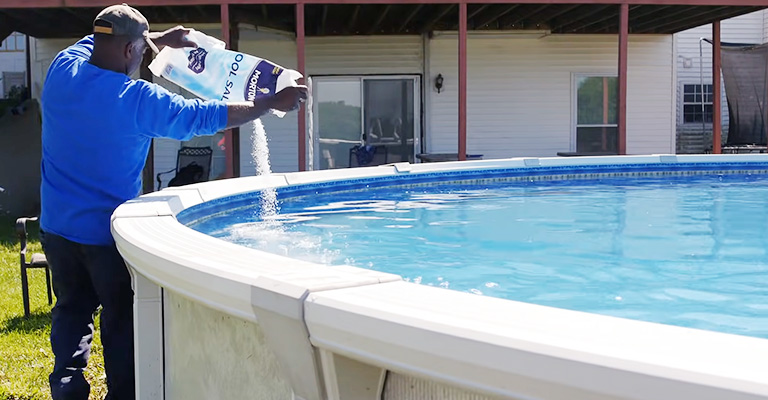
A lack of chlorine regularly added to the water is a primary cause of low free chlorine levels. When you add chlorine tablets to your skimmer, but the pump shuts off, that chlorine will not be able to reach your pool.
If you plan on using a chlorine floater, ensure that it has enough chlorine to cover the area you want to use it on.
Refilling the Pool with Fresh Water
Your water chemistry may be affected if you have just added fresh water to your pool. The amount of freshwater means there is a reduced need to sanitize, balance, and add chemicals to the pool.
Increased Organic Contaminants
As chlorine binds to everything in an attempt to sanitize your pool water during a heavy rain storm, your free chlorine will quickly disappear.
When your pool has experienced runoff, be sure to clear the debris from the water after a storm and shock it.
Very High Cyanuric Acid Levels
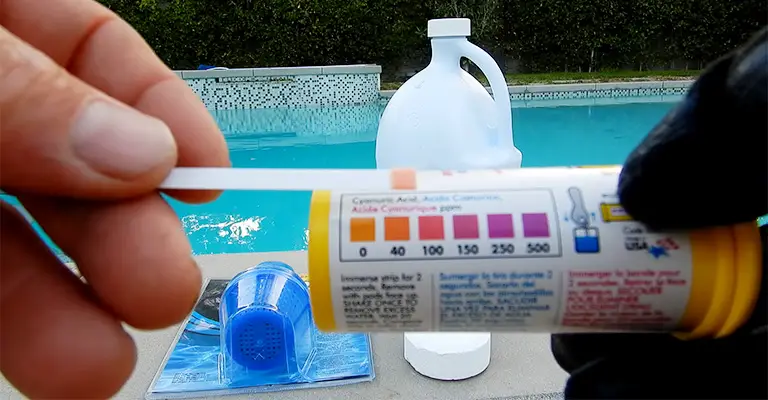
The effects of chlorine can be hindered if your CYA levels are too high. Your chlorine will have a weakened ability to sanitize your water with high CYA levels.
It will be consistent for your cyanuric acid to increase if you use 3-inch chlorine tablets (trichlor pucks). You should regularly check your CYA levels and make sure they remain within the 30 and 50 parts per million (ppm) range.
Sunlight and Low Cyanuric Acid Levels
Using unstabilized chlorine (like liquid chlorine or bleach) to sanitize your water will decrease concentration in the sun. It is because, without any stabilizers, the sun’s rays will break down your chlorine.
Heavy Pool Use
A pool where there are more swimmers and a pool that is used more frequently require more chlorine to fight contaminants. Over time, sunscreens, dirt, and even your own skin oil can make chlorine work.
To keep your water clean and chlorine levels high, shock your pool every week, especially after parties.
What Is Total Chlorine?
A total chlorine concentration is a sum of combined chlorine and free chlorine (combined chlorine + free chlorine).
Most inexpensive chlorine tests only show total chlorine. The total chlorine in a sanitized pool is identical to the free chlorine because clean chlorinated water contains no combined chlorine.
However, confirming the absence of combined chlorine without measuring free chlorine separately is impossible. Therefore, monitoring both free chlorine and total chlorine is essential.
As a result, total chlorine can be subtracted from free chlorine, which confirms the combined chlorine level.
What Is Combined Chlorine?
As free chlorine bonds to contaminants during sanitization, combined chlorine is produced. Contaminants can be found in the presence of combined chlorine and are being neutralized actively.
An aesthetically pleasing, sanitized pool contains zero combined chlorine. When the chlorine level in the pool water is consistently maintained, combined chlorine levels are much less likely to be detected.
What if Your Free Chlorine Levels are Constantly Low?
If you receive consistently low chlorine readings, test your cyanuric acid level. When your chlorine has low CYA, it is susceptible to UV rays from the sun. This will lead to a quicker burn-up of your chlorine.
However, you may be experiencing high chlorine demand. Despite the fact that chlorine is effective, it has a finite lifespan. When there are a lot of swimmers or debris and organic contaminants in the water, more chlorine is required to sanitize the water.
As your chlorine levels decline, your chlorine gets used up faster than you can replenish them. This problem can also be solved by shocking the pool.
You may need to add more salt to a saltwater pool or clean or replace your salt cell if you have low chlorine levels.
Why Is My Total Chlorine High But Free Chlorine Low?
A pool stabilizer in excess can chemically bind chlorine, rendering it inactive. The addition of too much stabilizer may have caused the problem.
In some cases, this can also happen if the pool water hasn’t been partially drained and replenished frequently. There is also a possibility that chlorine could be locked up due to a pH imbalance.
What Should I Do If Total Chlorine Is Higher Than Free Chlorine?
Total chlorine in the pool is more significant than free chlorine, which indicates contaminants present. Add together the free chlorine measurement and the total chlorine measurement to determine the amount of combined chlorine.
It is recommended to shock a pool if the combined chlorine is higher than 0.5 ppm. Depending on the level of chlorine in the system, either use a non-chlorine shock or a chlorinated shock.
How Does Chlorine Sanitize Pool Water?
The purpose of adding chlorine to pool water is to disinfect it. When free chlorine is exposed to water, it forms hypochlorous acid, which kills disease-causing microorganisms.
In the presence of chloramines, chlorine bonds with organic compounds, such as sunscreen and swimmers’ body fluids. Through off-gassing, chloramines, together with chlorine, leave the pool.
A buildup of chloramines causes the “chlorine odor” that swimmers complain about. An unpleasant smell may indicate poor water quality.
Keeping free, combined, and total chlorine levels in check will help detect water quality problems early on.
Is It Safe To Swim In A Pool With Low Chlorine?
The possibility of swimming in a freshly filled pool with low chlorine exists technically. However, contaminants will build up rapidly in the water.
The continuous use of a swimming pool with little chlorine might cause illness and eye or skin irritation. Using a pool with adequate chlorine is always better than balancing pool chemicals.
What Is More Important: Your Free Chlorine Or Total Chlorine Levels?
You need both, but it is important that your free chlorine levels are always higher than your combined chlorine levels.
A low free chlorine level plus a high combined level means you don’t have enough chlorine available to effectively sanitize your pool. As well as free chlorine, total chlorine includes combined chlorine.
Does Chlorine-Free Shock Raise Free Chlorine?
Unlike chlorine shocks, non-chlorine shocks don’t add chlorine to your pool, so its levels of free chlorine won’t increase. While chloramines – or combined chlorine – are removed by non-chlorine shocks.
How many shocks Do I Need To Raise Free Chlorine?
In pool shocking, you aim to raise free chlorine levels significantly and quickly above combined chlorine levels. You should use 1 pound of cal-hypo shock per 10,000 gallons of water if you are using it.
Final Words
It varies depending on your cyanuric acid level and how much you swim, but 1-3 ppm is generally considered an ideal range. The minimum free chlorine level is two for cyanuric levels of 30 (CYA).
A minimum level of free chlorine is three when it’s 40. Free chlorine minimum levels for cyanuric levels of 50 are 4. With an acid level of 60, cyanuric acid should have a chloride level of 5 to compensate.

